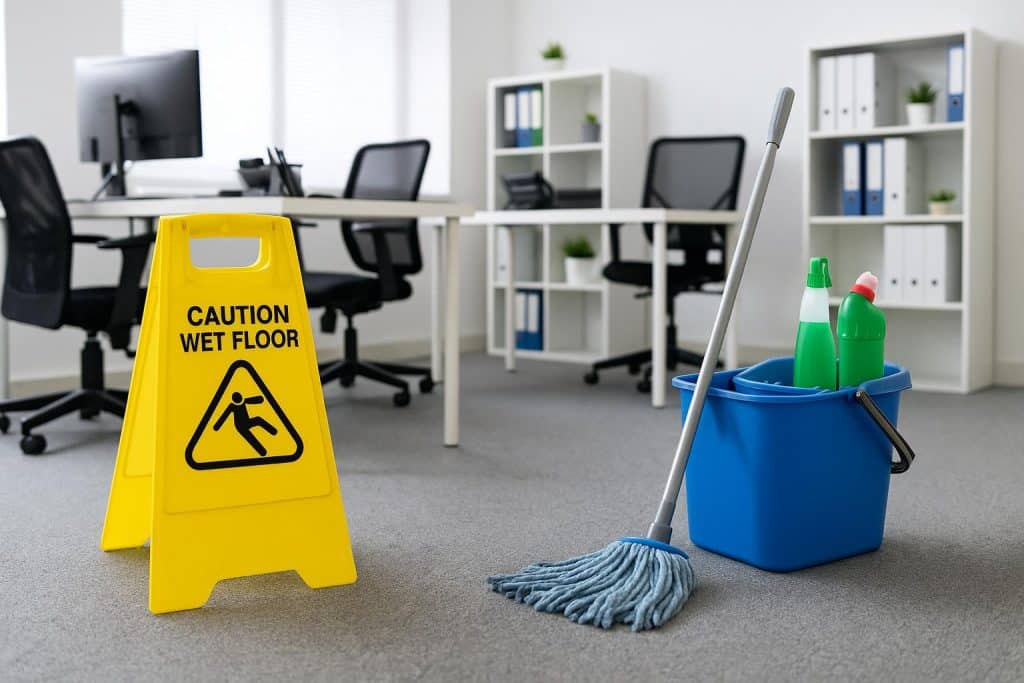Maintaining a clean office is more than just appearances — it directly impacts employee health, safety, and productivity. Many businesses underestimate how quickly dirt, dust, and germs build up, especially in high-traffic areas and busy work environments. Even small mistakes in planning, choice of cleaning products, or techniques can have significant long-term effects, leading to persistent mess, increased sick days, and higher maintenance costs. A workspace that isn’t properly cleaned can also affect staff morale and create a poor impression on clients or visitors. Companies that partner with professional cleaning services like RGS understand the importance of thorough, consistent cleaning. Understanding the most common cleaning errors and learning how to avoid them is essential for keeping offices hygienic, efficient, and comfortable for everyone who uses them.
Planning and Scheduling Mistakes
Infrequent or Inconsistent Cleaning
One common mistake is cleaning too rarely or inconsistently. Dust, crumbs, and germs don’t wait for the weekend or a designated cleaning day — they build up constantly. Offices that rely on occasional spot cleaning often see dirt spreading to multiple areas, including desks, shared equipment, and break rooms. Inconsistent cleaning can also lead to odours and a generally unhygienic workspace. Establishing a regular schedule, whether daily, weekly, or monthly, for certain tasks, ensures that small issues don’t become big problems and maintains a healthier environment for everyone.
Ignoring High-Traffic Areas
Another frequent error is overlooking high-traffic spots. Door handles, lift buttons, keyboards, and communal areas like kitchens or bathrooms are touched constantly, making them hotspots for bacteria. Focusing only on visibly dirty surfaces and ignoring these critical points increases the risk of germ transmission among staff. Businesses should identify the areas that get the most use and prioritise them during cleaning routines. A simple mapping of high-contact zones ensures cleaning resources are allocated efficiently and reduces potential health issues.
Using the Wrong Products or Techniques
Inappropriate Chemicals
Using the wrong cleaning products can cause more harm than good. Some chemicals damage surfaces like desks, laminate floors, or painted walls, while others may not be effective at killing bacteria or viruses. Mixing products incorrectly can even create hazardous fumes or neutralise their effectiveness. Choosing the right chemical for each surface and following the manufacturer’s instructions is essential. For example, a disinfectant designed for bathroom surfaces may be too harsh for electronic equipment or delicate furniture. Selecting appropriate products ensures both safety and proper hygiene.
Poor Equipment Use
Even the best cleaning products fail if equipment isn’t used correctly. Dirty mop heads, worn-out vacuum filters, or clogged spray nozzles can spread dirt and germs instead of removing them. Not following the manufacturer instructions for machines or failing to maintain tools reduces efficiency and can damage surfaces. Regularly replacing consumables, cleaning equipment after use, and training staff on proper usage keep the office cleaner and extend the life of your cleaning tools. Consistent maintenance of equipment is just as important as the cleaning products themselves.
Staff Training and Oversight Issues
Lack of Proper Training
A common problem in office cleaning is insufficient staff training. Cleaning personnel who aren’t familiar with best practices may miss key tasks, apply chemicals incorrectly, or fail to sanitise critical areas properly. This can compromise hygiene standards and even violate health regulations in some industries. Simple training protocols, including demonstrations and written instructions, help ensure everyone knows how to clean effectively. Regular refresher sessions also keep skills up to date, reducing mistakes and maintaining a consistently clean workspace.
No Accountability or Supervision
Even trained staff can fall short if there is no oversight. Without checks or audits, tasks may be skipped or done inconsistently, leading to uneven cleanliness across the office. Assigning responsibility for specific areas and implementing monitoring systems ensures standards are maintained. Accountability doesn’t mean micromanaging — spot checks, cleaning logs, or periodic inspections are often enough to keep staff on track. Proper supervision ensures that cleaning efforts deliver real results rather than just the appearance of a clean office.
Overlooking Long-Term Maintenance
Ignoring Floors, Carpets, and Upholstery
Many businesses focus on desks and visible surfaces but neglect floors, carpets, and upholstered furniture. Dirt and dust can embed in these areas, accelerating wear and reducing air quality. High-traffic zones are particularly vulnerable, and failure to deep clean periodically can lead to stains, odours, and even replacement costs. Implementing regular carpet cleaning, floor polishing, or upholstery maintenance prevents long-term damage, keeps the office looking presentable, and is more cost-effective than waiting until surfaces are irreparably damaged.
Neglecting Air Quality and Ventilation
Air quality is often overlooked in cleaning routines. Dust, allergens, and microorganisms can build up in vents and filters, spreading throughout the office whenever the HVAC system runs. Poor air quality can affect employee health, comfort, and productivity. Regularly cleaning and replacing filters, inspecting ventilation systems, and keeping ducts free of debris helps maintain a cleaner environment. Simple preventive steps like these complement surface cleaning, ensuring that both visible and invisible areas of the office remain hygienic.
Effective office cleaning goes beyond appearances. Mistakes such as irregular schedules, overlooking high-traffic areas, using inappropriate products, or neglecting equipment maintenance can reduce overall hygiene and create larger problems over time. Proper staff training, consistent supervision, and clear accountability ensure that cleaning tasks are performed thoroughly and correctly. Paying attention to long-term maintenance, including carpets, upholstery, floors, and ventilation systems, helps prevent wear and tear, improves air quality, and reduce replacement costs. By addressing these common issues proactively, businesses can maintain a cleaner, safer, and healthier workplace, which supports employee well-being, boosts productivity, and protects valuable office assets throughout the year.
